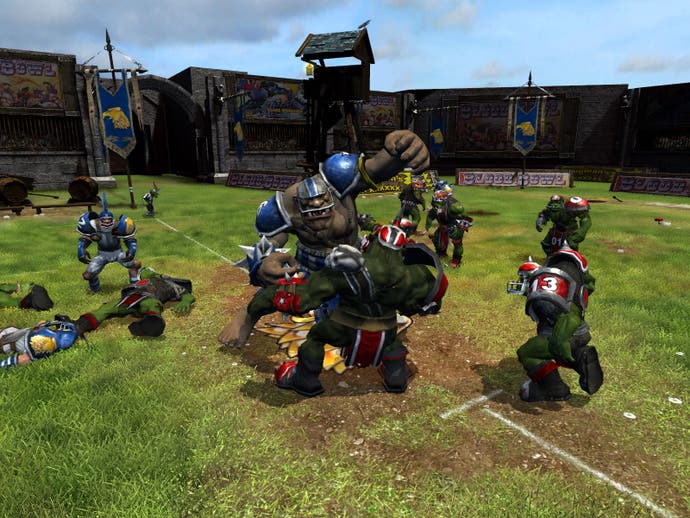Blood Bowl
Elf and fitness.
The real breakthrough, though, is the way that the simplified control system, using just the mouse buttons (mapped to face buttons in the 360 version), opens the game up, making it speedy and intuitive. The results are a mutation of Madden and Advance Wars, with hair and make-up by My Chemical Romance, but there's also a deep RPG system thrown in that sees your roster of sixteen players earning experience over the seasons, levelling skills, and eventually retiring through old age or - more likely - getting killed mid-game. The rolling roster system may seem brutal to those who get unduly attached to their procedurally-generated team-mates, but it should stop the game from becoming unbalanced, and there's an option to take a living snapshot of a favourite team in a golden era to export for exhibition matches.
With turn-based Blood Bowl already looking surprisingly accessible, real-time mode speeds things up even further, turning the game into one of frantic time-management. Even though everything's now happening at once, your team still depend on you to tell them what to do, play by play: you can assign basic behaviours (attack, defend, or stay neutral) but these merely control positioning on the board, and the game requires an exhaustive eye for detail. As a result, matches have a choppy, fire-fighting strain to them. A little of the turn-based pacing remains, however: moves have a refresh period between them, to stop things degenerating into a Click Festival sponsored by RSI Incorporated, and although the grid is no longer visible, the jerky, Tetris-like movement of the players leaves you in no doubt that it's still there. (There's no firm word yet on how all this will translate to the 360, where many an RTS has already keel-hauled itself, but Cyanide is currently thinking of dispensing with the mouse pointer entirely, opting for a closer camera and player selection using the triggers.)

As expected given the game's tabletop background, a huge portion of Blood Bowl is concerned with managing the team off-pitch and tweaking house rules. Cyanide has created an overabundance of customisation options, covering armour, team logos, and the look of characters, as well as variations in the minutiae of the rule-set itself. Teams can woo sponsors, bribe referees, dope their players to receive boosts, or even instigate random drug tests on enemies.
Featuring a season-by-season championship mode as well as a more traditional single-player campaign, Blood Bowl will also ship with online and LAN multiplayer. Gameplay films can be recorded and exchanged, and, crucially, the ability to craft bespoke teams, player by player and stat by stat, means tabletop gamers will be able to recreate their existing teams down to the last detail. Cyanide is not currently working on any DLC, but given the licence's intricate history, there's plenty of material to choose from. Elsewhere, alongside the identical PC and 360 versions, PSP and DS titles are also in the pipeline, both featuring online multiplayer, but ditching the real-time mode.
The core audience are definitely onboard: whenever I looked up from my demo screen, I saw dozens of faces clustered round, grinning stupidly and wondering if a lucky dice roll might bring the autumn release date closer. For everyone else, a few minutes of play will reveal a game that's full of character and surprisingly quick-paced. There's genuinely nothing like it on consoles at the moment, but it may not be easy wooing those who never played the original, given the perception of inaccessibility that hangs over the licence, and the slightly home-made look of the graphics. Games Workshop has clearly spent a lot of time and effort making Blood Bowl friendly and intuitive, but it's entirely possible the company's stone-clad walls may remain too intimidating for many to penetrate.
Blood Bowl is due out on PC and Xbox 360 this autumn.
